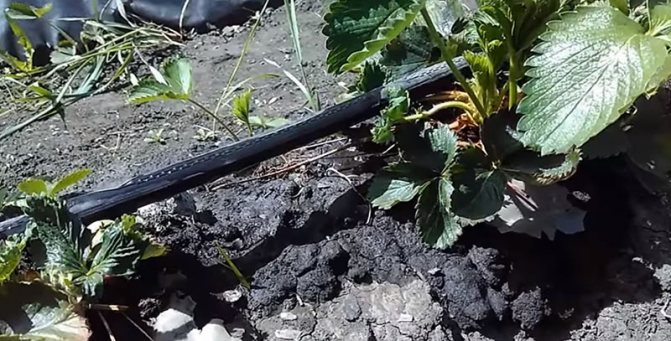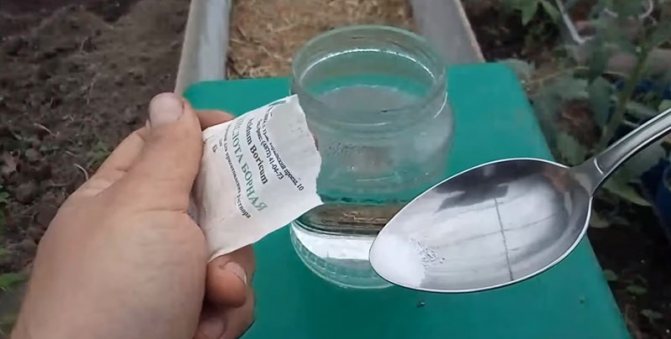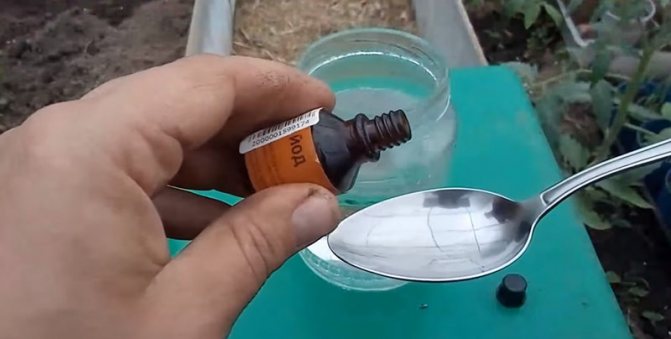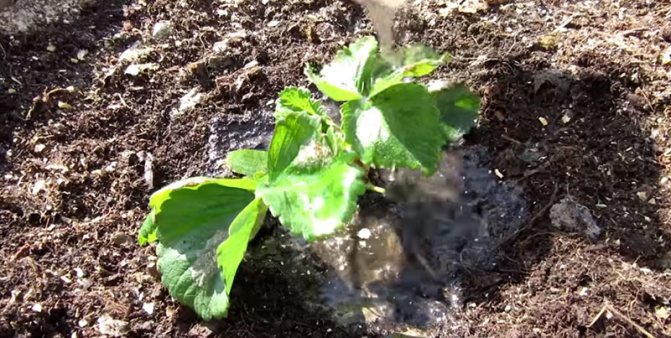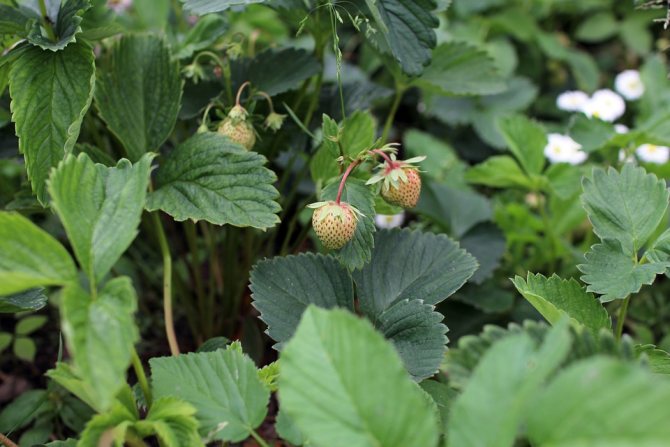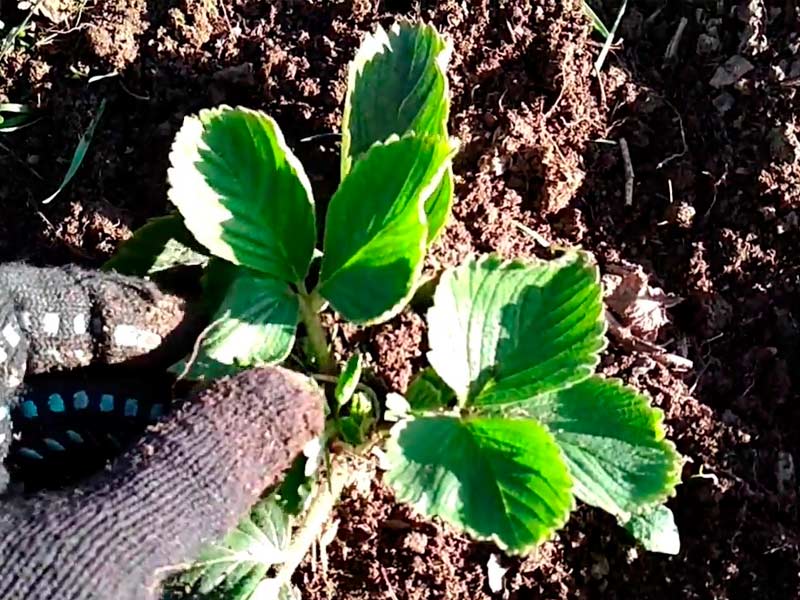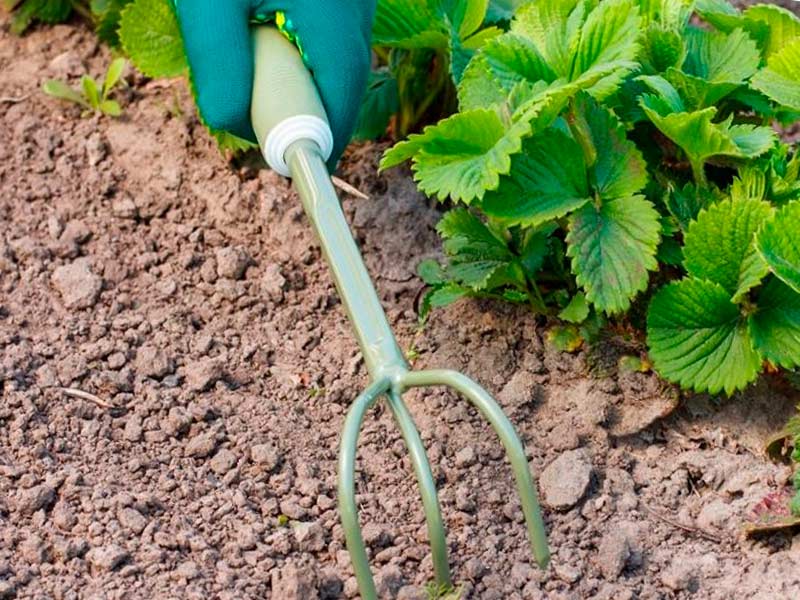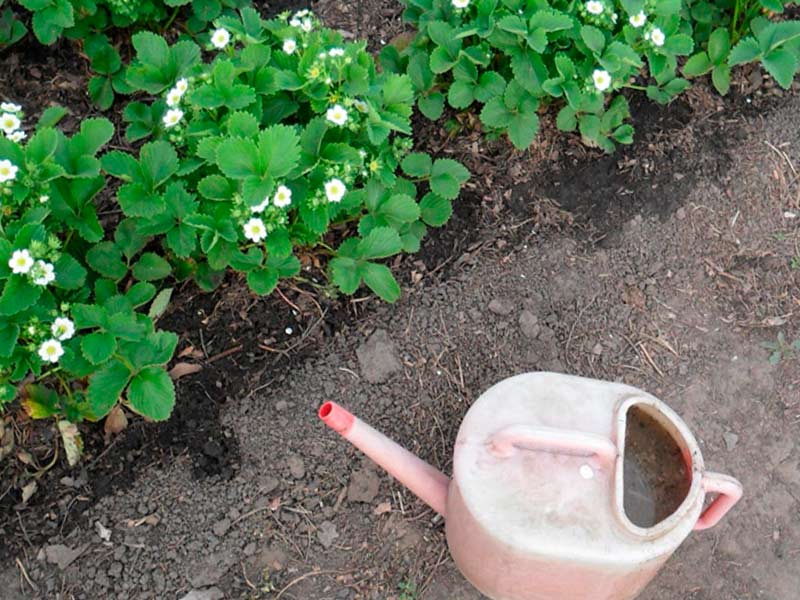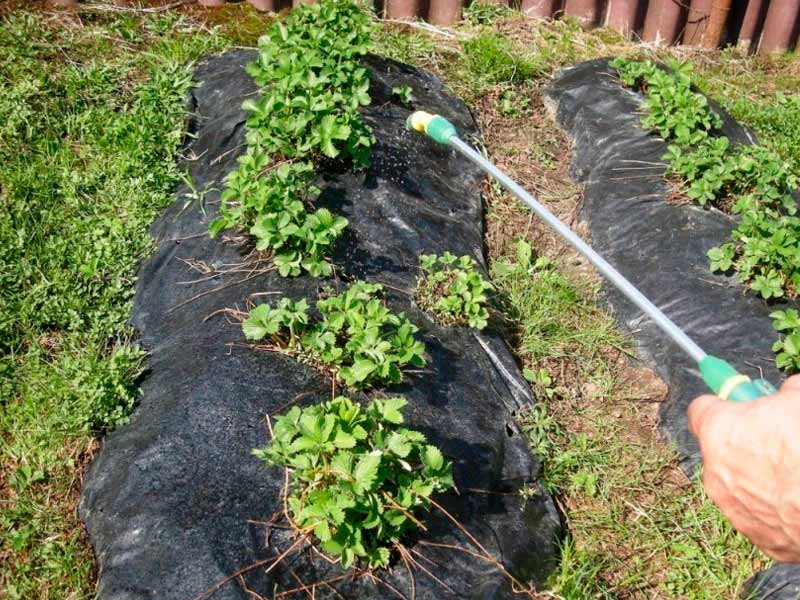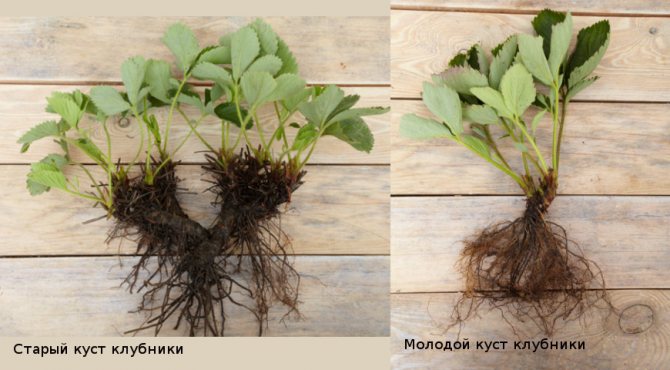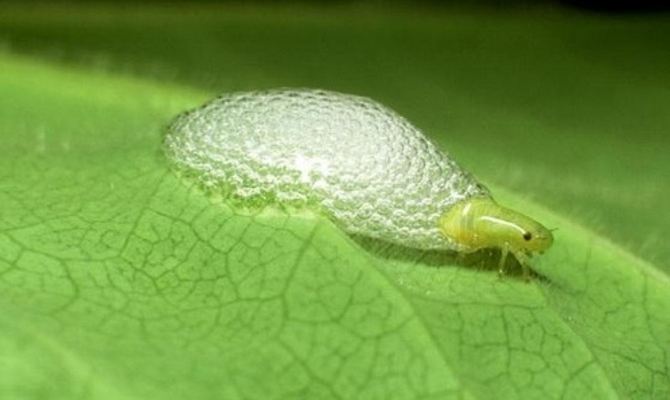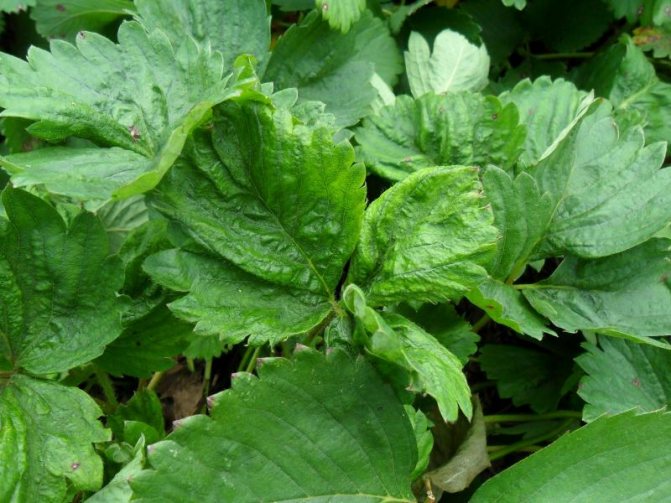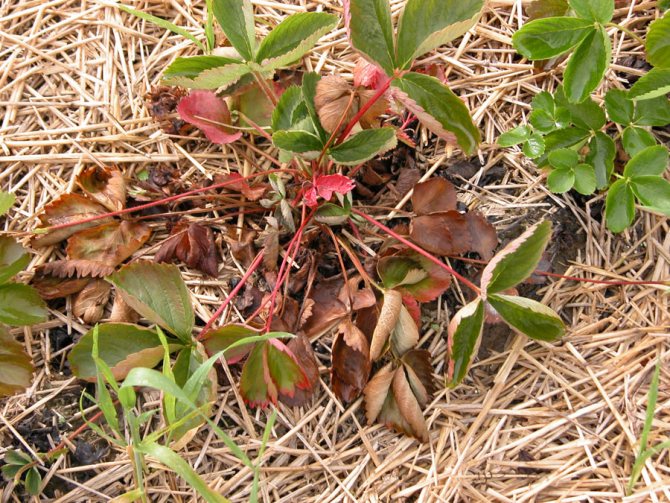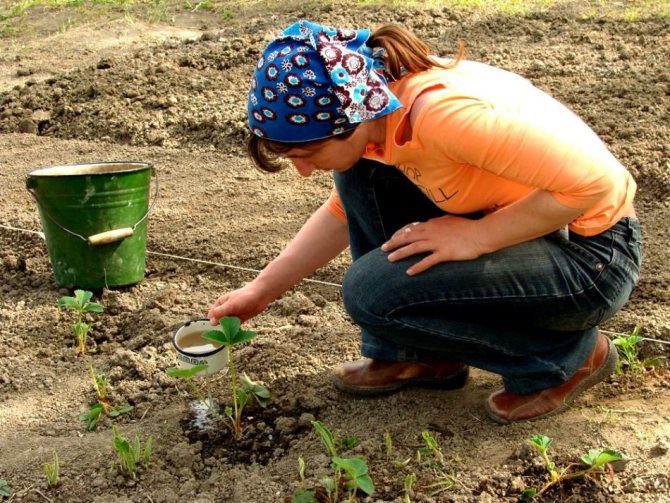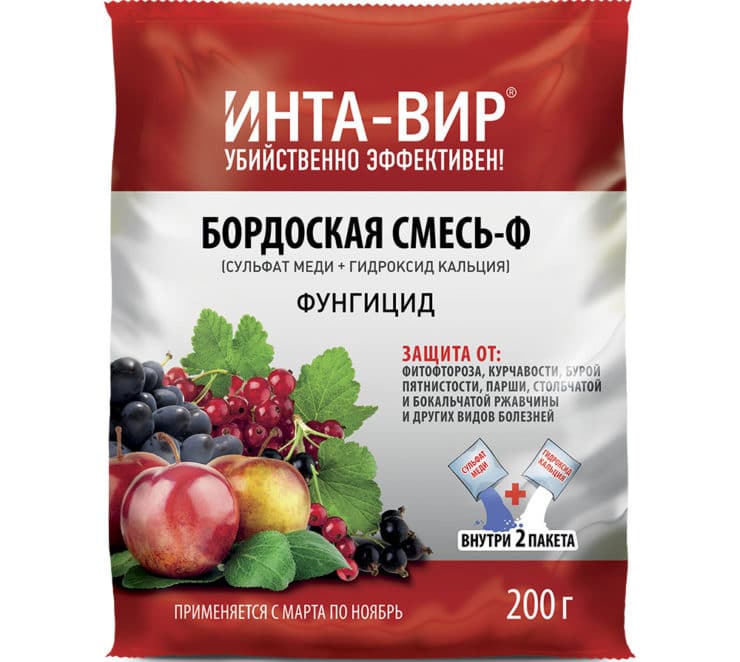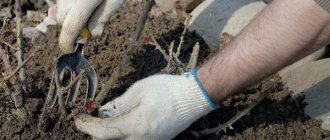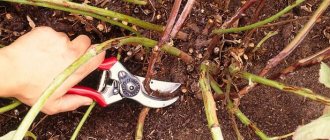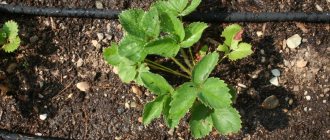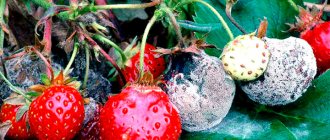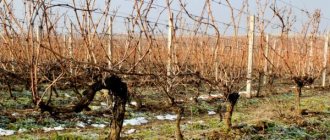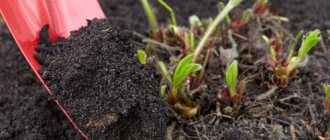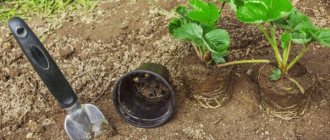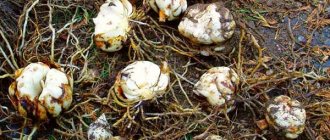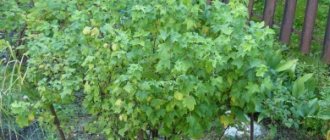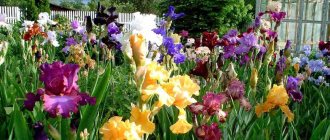In this article, we'll talk about how to care for strawberries in the spring correctly, what basic work with berry bushes needs to be done, how to feed them in order to get a rich harvest of tasty and healthy berries in the summer.
At the end of the winter trials, immediately after the snow cover disappears, as soon as the earth dries up, it's time to start cleaning up the strawberry plantation.
Spring strawberry care tasks involve following simple but must-have steps.
And it is important to complete them as soon as possible.
Features of strawberry care in spring
Agrotechnical manipulations for the cultivation of strawberries are not difficult, but require timely implementation. After the snow melts, as soon as the earth dries up, the first steps are taken to care for the plantings.
Did you know? Strawberry
—
the only one of the berries, whose seeds (about 200 pcs.) are not inside, but outside the fruit.
The main complex of performed procedures:
- cleaning the site - collecting mulch, removing trash, etc.;
- cleansing plantings - trimming mustache, old leaves;
- replanting old bushes - thinning, renewal of the site;
- watering - regular and timely;
- loosening - in the aisles and rows;
- adding fertilizers (top dressing);
- prevention of pests and diseases;
- mulching plantings.
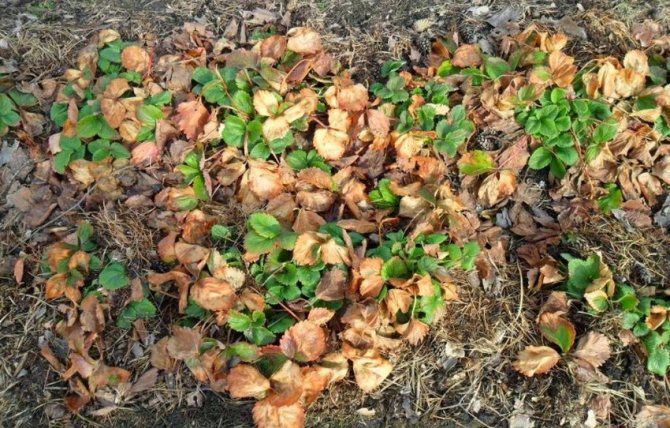
Strawberry bush after the snow melted. With the onset of the first spring heat, the aerial and root parts of the plant are actively awakening to growth, therefore it is important to carry out the planned work on the maintenance of berry plantings in time.
Spring processing of strawberries from diseases and pests
After harvesting strawberry beds and planting new seedlings, carry out preventive treatment of garden strawberry plants from fungal diseases that could move from plant residues to young leaves. For this, copper-containing fungicides are suitable: HOM, Horus, Bordeaux mixture, Abiga-Peak.
This will reduce the risk of damage to plants by powdery mildew, spots, verticillosis.
Strawberry mite - how to deal with a pest.
Raspberry-strawberry weevil: how to fight
Diseases of garden strawberries (strawberries)
Terms of strawberry care in different regions
The timing of spring activities for the care of strawberry plantations mainly depends on the region of growth of this species. The climatic conditions of different territories differ significantly from each other, therefore, the start of spring work in each zone occurs at a certain hour:
- southern regions - the first decade of March;
- western, eastern zones - from late March to early April;
- northern territories - from the second half of April to mid-May.
Typical mistakes
What does a gardener want to get from strawberry plantings, besides a good harvest? Naturally, admire the beautiful appearance of your bushes. To do this, you need to follow some simple rules, namely:
- Cut the bushes in time, clean the beds from litter and old mulch. Everything collected should not only be removed, but burned. Do not leave organic waste in the country, it is a breeding ground for pests and contributes to the development of diseases.
- It is not necessary to huddle the bush too high, as this blocks the access of air and moisture to the root system. As a result, the plant stops developing normally.
- The lack of a well-arranged mulch can cause berries to rot due to their contact with the ground. If the gardener does not like the mulching method, he should look for an alternative - plant strawberries in vertical beds or use special stands.
- Additional moisture is added to the soil only after sunset or in the morning. Under the scorching rays, evaporation occurs very quickly, and therefore improper, or rather, untimely watering is not beneficial.
- Do not place the berry on shady, sloping areas. With a lack of light, the plant stops blooming. Does not form fruit. The bay leads to rotting. The wrong planting site is another cause of disease.
- It is important to properly prepare the soil before planting young plants. The soil for the beds must be etched in order to destroy the spores of fungi and other pathogens, fertilize it to provide the plant with the necessary nutrition.
- Planting mustard and other green manures while preparing the soil for planting will improve the composition of the soil.
Advice! Follow these rules, and the berry will respond to the care of a good harvest.
How to properly care for strawberries
To obtain a generous and high-quality harvest, it is necessary to carry out the correct maintenance of strawberry plantations: to provide the plants with complete feeding, watering, protection from pests and diseases, and to carry out a number of additional work. You also need to know how to prepare planting specimens for landing on another area.
Cleaning plantings and pruning
After winter, as soon as the snow melts and the daytime air temperature reaches + 5 ° C, the winter shelter is removed (if used). To harden the plants, the covering material is first removed for several hours a day, gradually increasing the time interval every day. Only after 3-4 days it is removed completely. If plant materials (spruce branches, branches, straw, hay, sawdust, etc.) were used as insulation, they are also removed.
You will be interested to know what is the difference between strawberries and strawberries.
Next, the old mulch is removed. Removing the mulched soil with a layer of 3 cm will allow you to simultaneously remove pests hibernating there, and also make it possible to better warm up the soil near the plant with the sun. Pruning of bushes is carried out to a rosette of young green leaves. Defective and dried leaves, old tendrils and peduncles are cut with disinfected garden shears or pruning shears.
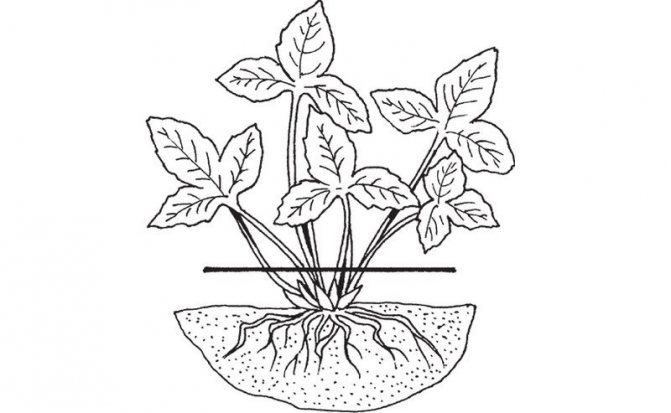

Tearing off unusable material is dangerous, as this damages the core and root system of the bush, the plant may die. When the plantings are thickened, young rosettes are removed. Weeds and dead strawberry bushes are subject to elimination. They clean the site with a garden rake. Taking preventive measures to combat pests and diseases, after harvesting, all natural waste is burned outside the site.
Video: pruning strawberries in spring
Transplanting old strawberry bushes in spring
In order to extend the fruiting period, adult bushes are planted in a new place. Usually they are planted where the frozen or dried plants have been removed to fill the voids and restore planting density. Fresh beds are also planted in order to rejuvenate the plantings. In autumn, strawberry seedlings form a strong, strong root structure, so a spring transplant is considered optimal.
Important! In one place, garden strawberries grow for 3-4 years with an abundant yield, then the productivity of the crop decreases, it needs to be transferred to another site.
The process for this activity is as follows:
- The old mother bush is dug up along with a lump of earth, which is removed.
- Carefully separate the bushes from the mother bush; each of them should have a strong root system 8–10 cm long and its own growing point (rosette) with 3 healthy leaves.
- Planting material is treated with a weak solution of potassium permanganate or any growth stimulant.
- A hole is prepared for planting (20–25 cm deep) by fertilizing the soil with humus, peat, ash or other nitrogen fertilizer, and water is poured in.
- The plant is planted in a hole and covered with earth, making sure that the core (growth point) is located at the height of the earth's surface. Slightly compact the soil.
- After planting the bush, watering is done.
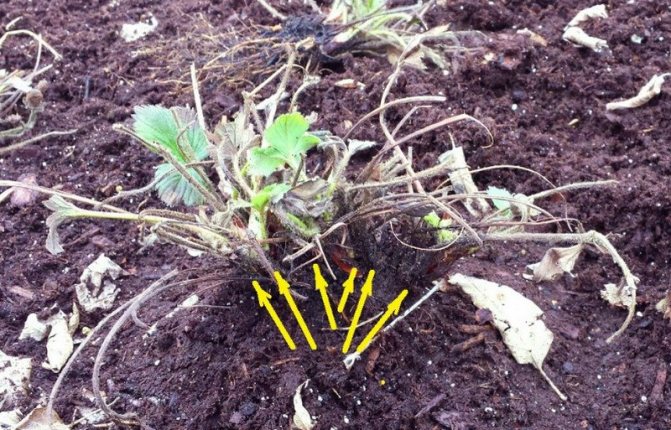

When planting plants in rows, the row spacing is 50–80 cm, and the gap between the bushes is 25–35 cm.
Watering strawberry plantings
The crop has a superficial root system that extends only 20–30 cm deep into the soil, which prevents the plant from extracting water from deeper moist layers. Lack of liquid adversely affects the growing season of the seedlings. After the snow cover melts, the soil is well saturated with moisture, so there is no need for irrigation.
With the arrival of spring heat, moisture evaporates quite quickly and it becomes necessary to water the plants, which is carried out regularly, as the soil dries up - about 1 time per week. The need for irrigation of the plants will help determine by visual inspection of the bushes in the afternoon. If strawberry leaves are lethargic, their edges are wrapped inward, then this is a visible sign of drying out of the soil and the reason for emergency watering of the plantings.
Learn how to water your strawberries often and correctly.
Proper care and watering is carried out:
- in the spring, in dry weather, once every 6-7 days;
- water at room temperature;
- with a water consumption per bush - about 0.5-1 l;
- with a depth of soil moisture after irrigation - at least 40 cm;
- observing the watering time - morning hours (before sunrise) or evening (after sunset);
- before flowering, strawberries are irrigated by sprinkling;
- after the buds appear, the plants are moistened at the root;
- planting material is watered daily for a week, then the procedures are reduced to 1 time in 3 days;
- no watering is carried out in cool, humid weather.
After moistening the plants, it is recommended to loosen the soil, which provides the root system with better air and moisture access. If the roots of old bushes are exposed on the surface of the earth, it is necessary to pour earth on them, slightly compact and moisten with water.
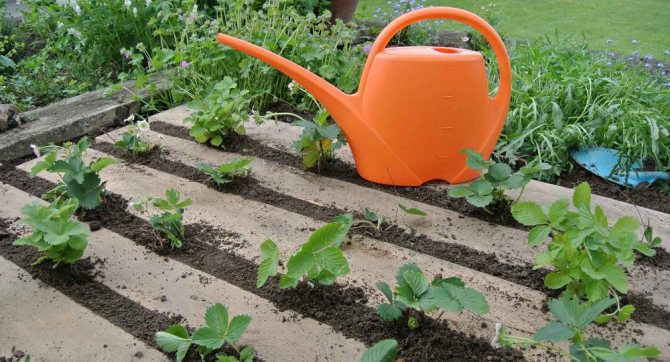

Mulching of beds (with a layer of 3-5 cm) with crushed bark, hay, peat and others will help to reduce the frequency of irrigation and to keep the moisture of the earth, to limit the growth of weeds. The use of film mulch is effective from inorganic materials. A dark film coating on the beds will allow to reduce the evaporation of moisture in the beds to a greater extent, to maintain a stable temperature regime.
Did you know? More than 300 varieties of strawberries are grown in the world, including white varieties that taste like pineapple.
Top dressing with organic fertilizers
From the beginning of the growing season to the beginning of fruiting, strawberries need to be fed to give the plants the strength to grow and the ability to form a good harvest. Spring feeding contributes to the rapid recovery of bushes after wintering and the formation of a sufficient number of ovaries.
The use of organic fertilizers among gardeners is considered the most acceptable option, since they are an environmentally friendly and safe product. But, as practice shows, it is reasonable to combine them or alternate with mineral fertilizers.
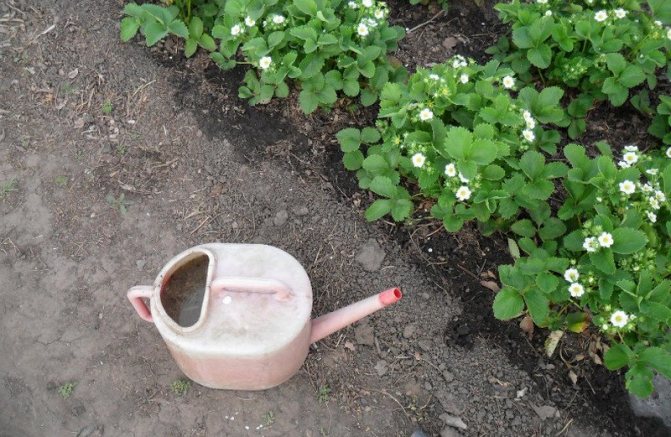

Spring feeding of strawberry beds takes place in three stages and at a certain time:
- After cleaning and pruning bushes.
- Before flowering (budding period).
- During flowering and first fruiting.
First feeding. For the dynamic growth of the aboveground part and the strengthening of the root system of plants that have just awakened after winter, nitrogen biological additives are used - for example, such solutions:
- 200 g of bird droppings in 10 liters of water is insisted for 24 hours;
- 300 g of mullein is diluted in 10 liters of water, defended for 2 days, add 1 tbsp. l. ammonium sulfate;
- Dissolve 25 g of urea in a bucket of water.
Application (watering) of nitrogen-containing fertilizer is carried out directly under the root of the bush at the rate of 0.5 liters for each plant.
Important! At the first feeding, for the timely and abundant fruiting of strawberries, it is recommended to use nitrogen fertilizers.
Second feeding. In order to increase the number of flower ovaries and reduce the formation of barren flowers, the following types of dressings are used:
- a quarter of a bucket is filled with manure (horse, cow), water is added to the top, insisted for 72 hours, the resulting substance is diluted with water in a ratio of 1: 4, the beds are watered - 10 liters per 1 m²;
- in a bucket of water, bred 2 tbsp. l. iodine, 5 g of boric acid, 120 g of crushed wood ash, stir, pour 500 g of liquid under the seedling.
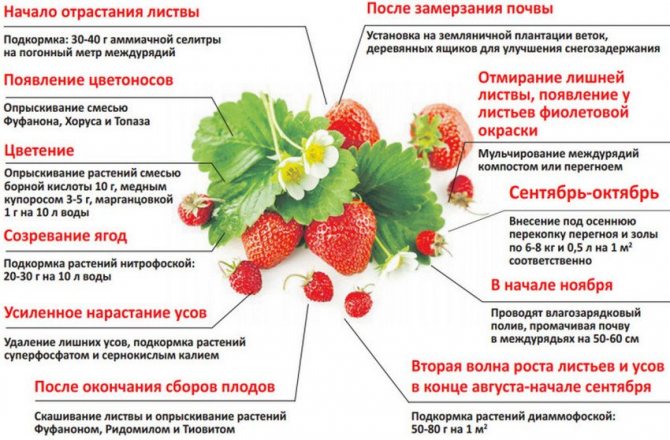

Third feeding. It is carried out with the use of complex mineral fertilizers containing potassium, magnesium and phosphorus - this allows you to achieve a generous harvest with large, colorful berries and provide prevention from diseases.
These tools include:
- nitroammofoska: 1 dessert spoon of the substance is poured under the bush;
- 2 tbsp. l. nitrophosphate, 1 tbsp. l. Dissolve potassium sulfate in 10 liters of water, watering rate - 0.5 liters per plant;
- superphosphate: make 30 g per 1 m²;
- potassium sulfate: 10-15 g per 1 m²;
- complex formulations: Stimovit, Azofoska, Kristallon, Agricola, Krepysh, etc. (use according to the instructions for use).
We recommend that you learn how to feed strawberries after harvest.
Mineral dressing must be accompanied by abundant watering of the plants. Each gardener, taking into account the structure of the soil, the use of the composition of fertilizers in autumn and the state of plants after wintering, individually determines the need for the use of various types of fertilizers for strawberry plantations in the spring.
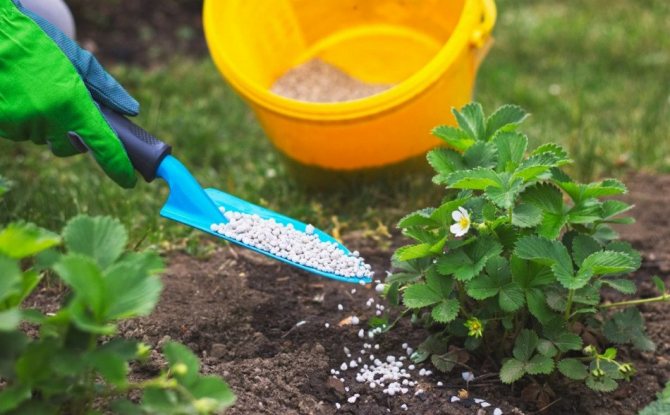

Pest control and disease prevention
Strawberries, unfortunately, are susceptible to many types of diseases (brown spot, gray rot, etc.) and suffer from insect invasions (strawberry mite, bear, weevil, etc.). The reasons why these unfavorable moments arise can be different: unfavorable weather conditions, non-observance of the rules of agricultural cultivation of crops, planting infected planting material, the use of non-disinfected garden tools, etc.
Important! It is not recommended to plant strawberries near the raspberry patch, as the weevil is their common pest.
Therefore, an important role is played by the fulfillment of the basic requirements for the maintenance of plants and the adoption of timely preventive measures to protect strawberry bushes from diseases and pests. If parasitic insects are found, urgent measures are taken to eliminate them.
Here's what to do with strawberries if there are main types of pests on the beds:
- Medvedka... A malicious pest that lives in the soil and eats not only green mass, but also berries. Insectoacaricides - "Terradox", "Vofatox", "Medvetsid", biological product "Rembek" are effective in counteracting insects.
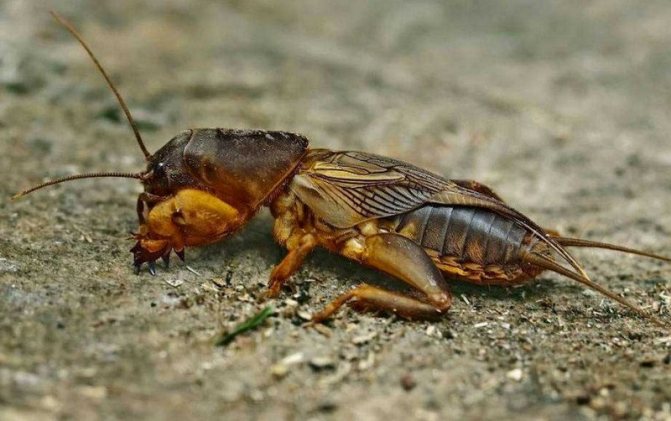

- Strawberry, spiderweb, transparent mites... Common strawberry parasites that feed on leaf juices. Apply "Fitoverm" (20 g of the drug is diluted in 10 liters of water) in early spring and during flowering. In the first spring days, "Karbofos" or "Phosphamide" (60 g of substance per 8 liters of water) is used for prophylaxis, and "Neoron" is used 10 days before flowering.
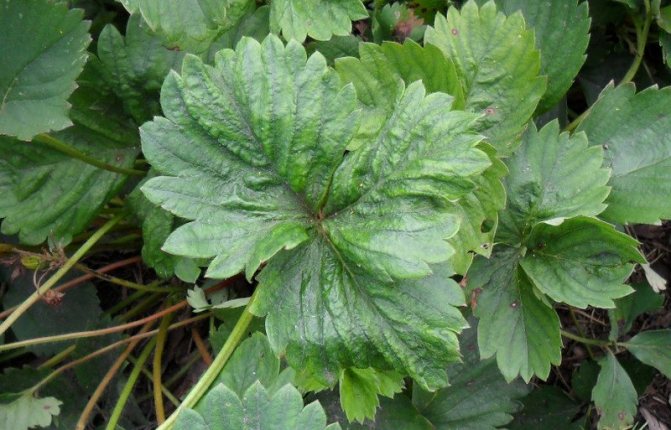

The main signs of the presence of a strawberry mite. - Weevil... Dangerous dark gray bugs that can destroy the entire early crop of a crop. To combat them, the following means are recommended: "Confidor", "Decis", "Karbofos". Processing is carried out a week before the flowering of the bushes. From folk methods, they use a decoction of onions, celandine, tansy.
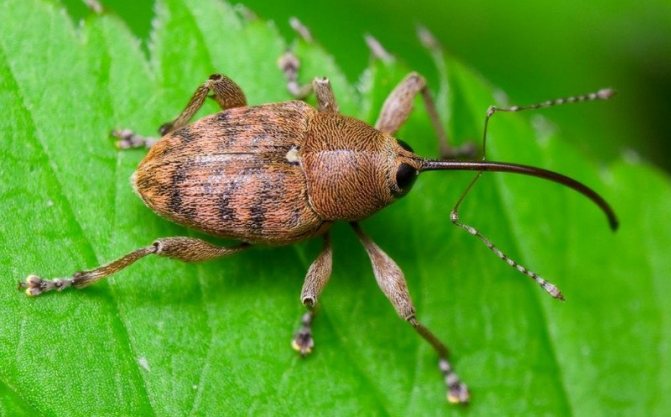

Strawberries are susceptible to a number of infectious and viral diseases:
- Gray rot of fruit (botrytis) is a fungal disease. It manifests itself especially in rainy weather, in the form of gray mold on the ovaries and berries. Recommendations: spraying before flowering with the biological product "Alirin", "Forecast", "Zircon" (according to the instructions), Bordeaux liquid, ash infusion (150 g of substrate per 10 liters of water).
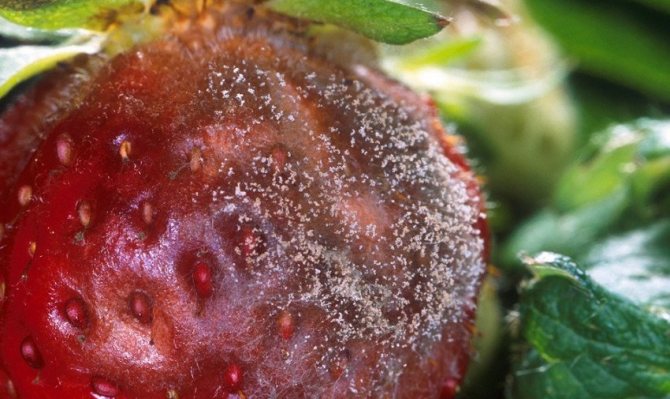

- Powdery mildew... The appearance on the leaves and fruits of a white bloom, which is formed as a result of fungal infection. At the first signs of this ailment, the biofungicide preparation Fitosporin-M is used, according to the instructions (once every 14–20 days), Topaz, soda ash solution (50 g of substance per bucket of water).
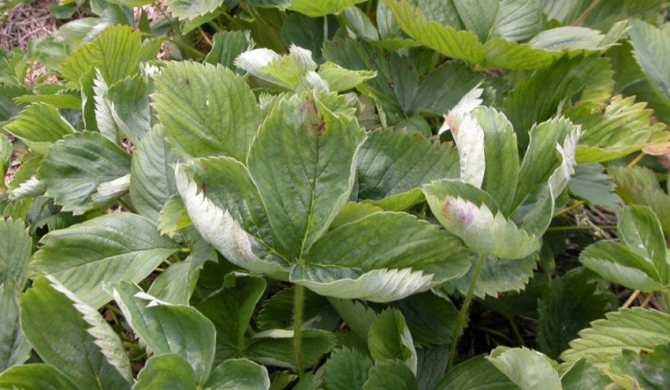

- Brown spot... Disease on the leaves in the form of brown spots, caused by parasitic spores of the fungus. With a strong infection, the whiskers and stalks die. The yield is reduced by 8-14%. Control measures: the use of fungicides "Horus", "Forecast", "Ridomil Gold", "Ordan", a solution of potassium permanganate (5 g of manganese per 10-12 liters of water).
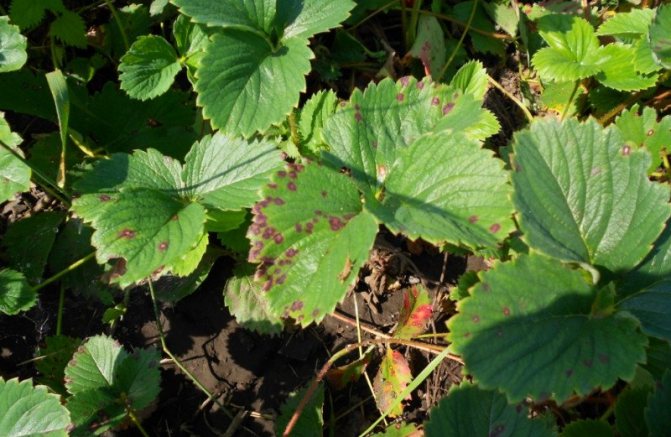

Taking preventive measures to protect strawberry plantations from various ailments and parasitic insects, it is possible to reduce their spread in the garden area and even get rid of them completely.
For these purposes, it is necessary to carry out the following operations:
- follow the rules of crop rotation (you cannot plant strawberries in the garden where cabbage, sunflowers, melons and legumes, potatoes, onions, peppers previously grew);
- transplant strawberries to a new site every 3-4 years;
- disinfect planting material, agricultural implements;
- remove sick, infected plants from the beds;
- timely use of chemicals and folk remedies to protect plants from diseases and parasites.
Learn how to treat pests and diseases on strawberries.
Spraying with Epin to support immunity
Often, strawberry bushes come out of wintering weakened, frozen. It is useful to treat such plants with an immunity stimulant Epin Extra. For 3 liters of water, take 24 drops of the drug. Spraying is carried out until abundant wetting of live leaves and "heart", at positive air temperatures.
Epin Extra is useful to apply during the period of peduncle extension, if recurrent frosts are expected. Irrigation with the drug is done a day before the expected decrease in temperature, and then immediately after the cataclysm.
Gardening tips for beginners
Those who have recently started cultivating berry plants should adopt the advice of experienced gardeners:
- place berry rows in the south-west of the garden plot, with good lighting and protection from the wind;
- choose light, loose soil for strawberries; sand and peat are added to dense, heavy soil;
- the planned beds for planting in the spring must be fertilized in the fall: add humus, compost to the soil;
- plant only healthy, disinfected specimens;
- during the growing season, remove the first mustache to enhance the growth of the bush and abundant flowering;
- feeding strawberries in recommended doses using different types of fertilizers: organic, mineral, complex;
- do not use herbicides for treating the soil from weeds (the chlorine contained in them significantly reduces the yield of the berry);
- use drip irrigation to irrigate plantations;
- regularly carry out preventive examinations of strawberry bushes.
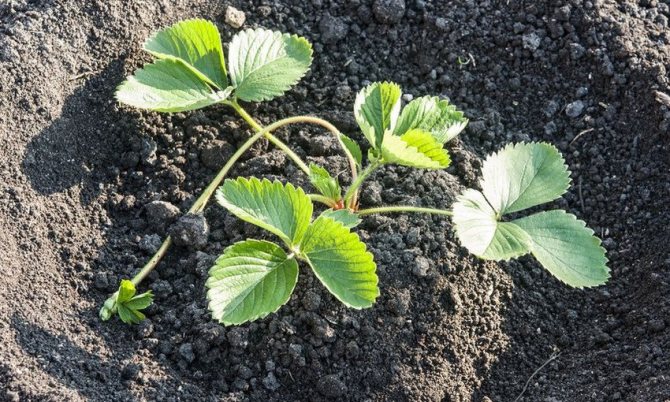

Timely and proper care of garden strawberries in the spring is the most important thing in the complex of work performed on the cultivation of this berry. With a little effort, showing care and competent agricultural technology when growing a garden crop in your country house, you will certainly get the expected result: a generous harvest of a fragrant, juicy, sweet and tasty dessert.
Foliage cleaning
This work can be done before dousing with hot water or a little later. Remove unnecessary leaves from the strawberry plantation - dry, withered, yellowish, with spots. Along the way, remove the weak autumn "mustache". On small beds, young bushes, sparse plantings, the operation can be carried out manually using a pruner or garden shears. Large plantations with dense foliage are cleaned with a fan rake or similar tool. The collected waste is incinerated or placed in deep long-term compost.
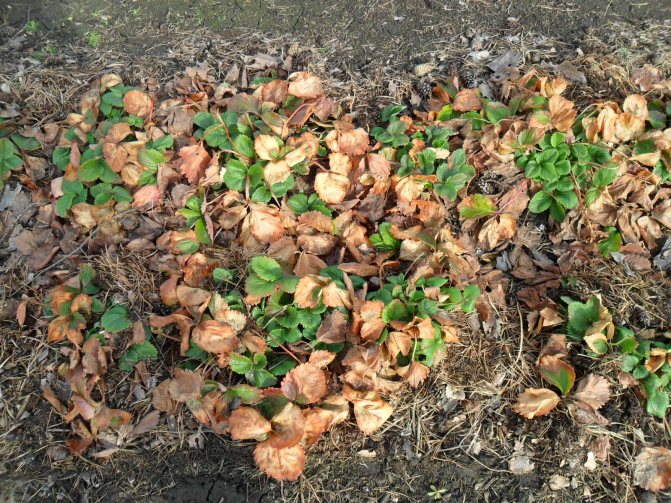

Mulching
Another of the stages of strawberry care is mulching - covering the surface of the earth with organic or artificial materials.
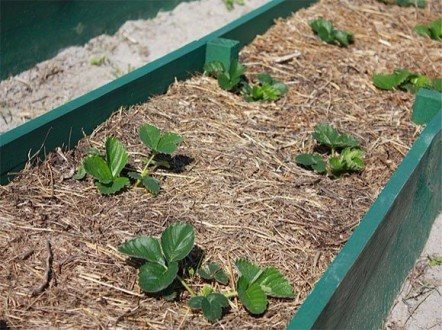

The earth is covered with a thin layer of straw, peat chips, small sawdust or ordinary humus. Note that this slows down the germination of weeds. The procedure provides moisture and air access to the roots of the plant.
The next mulching is carried out at the beginning of strawberry fruiting. This allows the emerging berries to avoid the process of decay and pollution.
Watering
For the normal development of garden strawberries in the spring and their full growth, it is necessary to provide them with regular watering.
It is best done in the morning hours before the onset of the heat. The water must be warm.
When watering, you should try not to touch and in no case damage the leaves or flowers.
How often to irrigate? It directly depends on the weather and climatic conditions of the area. As a rule, it is carried out once a week. However, in dry spring it is recommended to do this much more often (3-4 times a week). In the rainy season, the plant does not need to be watered at all.
After moistening the soil, you should loosen it well under the bushes. Please note that watering must be abundant. In this case, the soil will be completely saturated with moisture.
Many seasoned gardeners recommend using the sprinkler technique. It consists in the fact that water under pressure with the help of a special apparatus is crushed into drops and falls on the plant in the form of a kind of artificial rain.
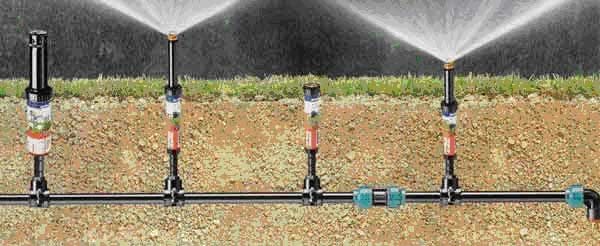

The devices for this procedure are lightweight, portable tubing fitted with a nozzle. You can buy them in a specialized store or on the Internet.
Today, the sprinkling technique is one of the most advanced ways to water strawberries. She has the following advantages:
- Ensuring good development of the root system of the plant.
- Creation of a favorable microclimate on the land plot.
- Improving soil fertility.
Transfer
Old bushes growing in the beds are recommended to be planted. This will avoid unnecessary thickening of the landings. The optimal period for planting is considered to be the time when young greenery is actively growing. At this time, the growth of the root system is activated, so strawberries will not notice a slight damage to it, the transplant can be painless.
Bushes that are planning to transplant must be carefully examined. Strawberry bushes lacking new leaves are not suitable for further cultivation. If the entire bush is brown or gray, then this means its death or damage by disease. They do not take it for transplantation. Remove damaged specimens along with a lump of earth, because soil pests may be in the soil near the roots.
Advice! For better survival rate, strawberries are recommended to be transplanted with a lump of earth.
Chemicals
The use of chemicals is advisable when symptoms of disease or damage to plants by insects appear. It is necessary to process the site in a protective mask and gloves. The action of some drugs is aimed at combating pathogenic microorganisms, others - against pests. There are means that have a complex effect and simultaneously eliminate both diseases and insect parasites.
From pests
- Fitoverm - this biological insectoacaricide is effective against strawberry mites, aphids and other insects. To prepare a working solution, an ampoule of the drug is dissolved in 1 liter of water. The first time the beds are sprayed in early spring, when the first leaves appear. The second treatment of strawberry beds is carried out after 10 days.
- Metaldehyde is an insecticide used to control slugs and snails. The product is produced in the form of blue granules, which attract pests with their smell and, upon direct contact, dry out the mucous membranes, which causes their death. In places where slugs were found, the earth is sprinkled with granules at the rate of 15 g per 5 m². The drug has a hazard class 3, it can harm humans and animals, especially dogs.
- Thunderstorm - used against snails and slugs, it has a safer effect compared to the previous drug. The form of release is blue granules, which are sprinkled on the soil in the aisles of strawberries. Since the Thunderstorm, in addition to other substances, contains the substance Metaldehyde, care should be taken when carrying out treatments.
- Karbofos - refers to insecticides, is available in the form of granules, powder or emulsion. It is used as a solution for spraying bushes in the fight against aphids, weevils, ticks and other insects. The working solution is prepared at the rate of 70 g of granules or powder per 10 liters of water.
- Akarin - used to kill ticks, ants and aphids on strawberries. Acarin is sprayed on plants in the evening or morning. The optimum temperature for processing is 12-25 degrees Celsius. To prepare a solution, an ampoule with a volume of 4 ml is dissolved in 1 liter of water.
Recovery stage
What to do with strawberries in spring, where to start?
One of the stages of plant care is its recovery after the winter cold. The procedure is carried out in early spring when the weather is warm and dry.
Recovery work includes:
- Cleansing the soil from plant roots, weeds and last year's frozen foliage. Please note that if damaged and blackened leaves are found on strawberry bushes, they must be removed.
- Removal of the top soil layer (approx. 3 cm). Thanks to this, it is possible to achieve good heating of the plant root system.
- Loosening the earth around the bushes.
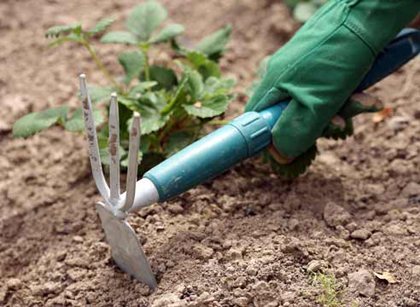

By doing all of the above, you will completely restore the soil and strawberries after winter. As a result, you can confidently expect a harvest of red and juicy berries in due time.

